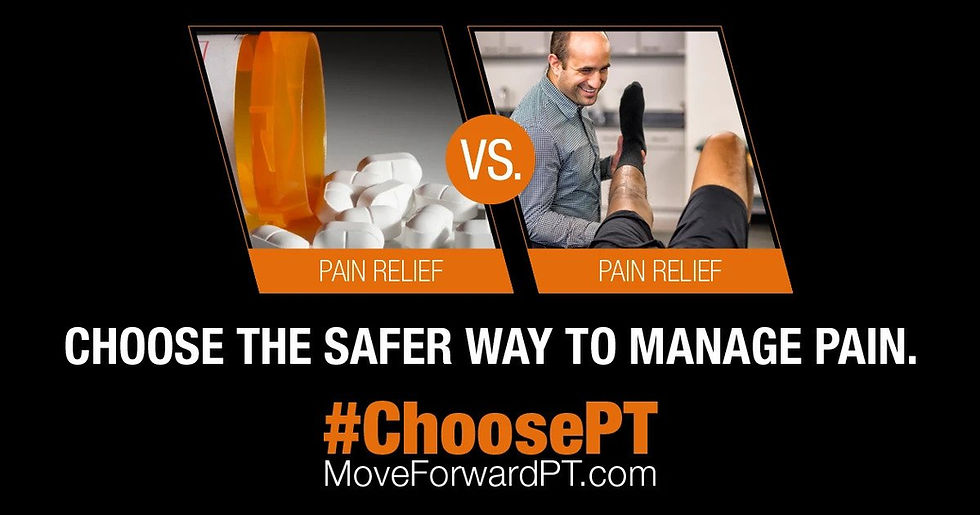Pills or Pain Relief?
- flexplus
- Aug 12, 2022
- 3 min read
Updated: Aug 28, 2024
Physical therapists are pretty amazing medical professionals: they are experts on the mechanics of the whole body! A physical therapist can help with muscle, tendon, and ligament disorders, joint pain and arthritis, and strengthening. They can also help with so much more - balance and vestibular disorders, neurological disorders like Parkinson's, cerebral palsy, and post-stroke, TMD (jaw pain), prosthetics, orthotics, and even certain degrees of paralysis.

According to the US Department of Health and Human Services, America is in the throes of an opioid epidemic. As of 2014, at least half the opioid deaths in the United States involved prescription opioids.
Pain medications such as Oxycodone, Vicodin, and morphine are quick ways to pain relief. For most people, use in a limited quantity for a limited time do not become problematic. However, the risk for misuse is real. The Centers for Disease Control and Prevention (CDC) states that every day, over 1,000 people are treated in emergency departments for misusing prescription opioids, and as many as 1 in 4 patients prescribed opioids for non-cancer treatments struggles with addiction.
Physical therapy's primary focus is relieving pain and improving function. Physical therapists are evidence-based healthcare professionals who provide cost-effective treatment. If necessary, physical therapy can be used in conjunction with an individually-tailored program of strengthening, stretching, hands-on therapy, and modalities, physical therapy can be as effective as opioids at relieving pain without the dangers of drugs.
Patients should choose physical therapy instead of opioids when ....
.... The risks of opioid use outweigh the rewards.
Potential side effects of opioids include depression, overdose, and addiction, plus withdrawal symptoms when stopping opioid use. Because of this, "experts agreed that opioids should not be considered first-line or routine therapy," the CDC guidelines state.
.... Patients want to do more than mask the pain.
Opioids reduce the sensation of pain by interrupting pain signals to the brain. Physical therapists treat pain through movement while partnering with patients to improve or maintain their mobility and quality of life.
.... Pain or function problems are related to low back pain, hip or knee osteoarthritis, or fibromyalgia.
While physical therapy helps with numerous conditions, the CDC cites "high-quality evidence" supporting exercise as part of a physical therapy treatment plan for those familiar conditions.
... Opioids are prescribed for pain.
Even in situations when opioids are prescribed, the CDC recommends that patients should receive "the lowest effective dosage," and opioids "should be combined with non-opioid therapies" such as physical therapy.
.... Pain lasts 90 days or more.
At this point, the pain is considered "chronic," and the risks for continued opioid use increase. An estimated 116 million Americans have chronic pain each year. The CDC guidelines note that non-opiod therapies are preferred for chronic pain and that "clinicians should consider opioid therapy only if expected benefits for both pain and function are anticipated to outweigh risks to the patient."
If you or someone you know is suffering, or on opioids and would like other options, please let us know, we'd love to help. Call FlexPlus Physical Therapy at 508-650-0060 to set up an evaluation. Not sure if physical therapy is right for you? Ask us for a free pain consultation! We're With You Every Step of the Way.
Also, you can learn more about the APTA's pills vs. pain relief, #choosePT campaign at their website, www.MoveForwardPT.com/choosePT.
https://www.apta.org/NPTM/
http://www.moveforwardpt.com/DidYouKnow/Detail.aspx?cid=cd52bad5-f4a3-4f1f-a387-9cd4a3bc1842
http://www.moveforwardpt.com/Resources/Detail/physical-therapy-vs-opioids-when-to-choose-physica
#FlexPlus #PhysicalTherapy #choosept #painrelief #painmanagement #fibromyalgia #flexplus #vestibulardisorder #carpaltunnelsyndrome #carpaltunnel #painfree #noninvasive #freeconsultation #falls #jointpain #tmd #tmj #lowerbackpain #lbp




Comments